Andros
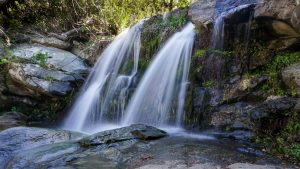 You do not often see an island that combines dry Cycladic landscape and plenty of water. Museums, events and neoclassical architecture. Countless beaches and imposing mountains. These geographical and morphological contrasts make it really special. This island is Andros and according to Andreas Empirikos Andros is “the island of the eagle, the queen of the Aegean… the most beautiful of all the world”.
You do not often see an island that combines dry Cycladic landscape and plenty of water. Museums, events and neoclassical architecture. Countless beaches and imposing mountains. These geographical and morphological contrasts make it really special. This island is Andros and according to Andreas Empirikos Andros is “the island of the eagle, the queen of the Aegean… the most beautiful of all the world”.
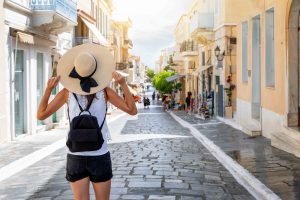 Andros has four central points, but not defying the wonderful settlements with their own history! The capital is Chora located in the northeastern part of the island. It is built on a small peninsula that seems to “cut” the sea in two. Gavrio is the central port, which is the gate of the island and built at the mouth of the sheltered natural bay on the northwest side of the island. Korthi Bay, or Gialos is located in the southern part of Andros, between the mountains formed by Gerakones and Rachi. And Batsi, picturesque and built by the sea, in the east of the island, with intense night life.
Andros has four central points, but not defying the wonderful settlements with their own history! The capital is Chora located in the northeastern part of the island. It is built on a small peninsula that seems to “cut” the sea in two. Gavrio is the central port, which is the gate of the island and built at the mouth of the sheltered natural bay on the northwest side of the island. Korthi Bay, or Gialos is located in the southern part of Andros, between the mountains formed by Gerakones and Rachi. And Batsi, picturesque and built by the sea, in the east of the island, with intense night life. The natural beauty of Andros
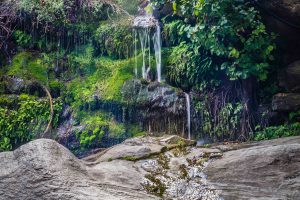 The river Achlas originates from Petalo, one of the highest peaks in the Cyclades. It flows into the homonymous beach and “holds” even in summer. The Arnipotamos flows into the bay of Lefka and the Great River from Stavropeda flows into Paraporti. In Andros you will see several waterfalls. The waterfall in Pithara has access with a short hike, in Paleopolis the waters you will see fall from above.
The largest source is Zenio. The largest volume of water of Zenios flows to all sides of the island. The Cold Fountain on the north side of Petalos, the Koumoulos spring in Menites are some of the scattered throughout the island. The Sariza spring in Apoikia, with the eponymous table water, you consider thermal.
Trees such as plane trees, willows, poplars, oaks, pine trees, maples abound in Andros. Among them emerge spruce, oleanders, figs, mulberries, olive trees, reeds, lettuce, laurels, phrygana. In spring the wildflowers compose an incredible carpet of anemones, orchids and bells. The aromas from the gardens and the boxwoods are mixed with the thyme, the oregano and create an intoxicating atmosphere.
The river Achlas originates from Petalo, one of the highest peaks in the Cyclades. It flows into the homonymous beach and “holds” even in summer. The Arnipotamos flows into the bay of Lefka and the Great River from Stavropeda flows into Paraporti. In Andros you will see several waterfalls. The waterfall in Pithara has access with a short hike, in Paleopolis the waters you will see fall from above.
The largest source is Zenio. The largest volume of water of Zenios flows to all sides of the island. The Cold Fountain on the north side of Petalos, the Koumoulos spring in Menites are some of the scattered throughout the island. The Sariza spring in Apoikia, with the eponymous table water, you consider thermal.
Trees such as plane trees, willows, poplars, oaks, pine trees, maples abound in Andros. Among them emerge spruce, oleanders, figs, mulberries, olive trees, reeds, lettuce, laurels, phrygana. In spring the wildflowers compose an incredible carpet of anemones, orchids and bells. The aromas from the gardens and the boxwoods are mixed with the thyme, the oregano and create an intoxicating atmosphere.
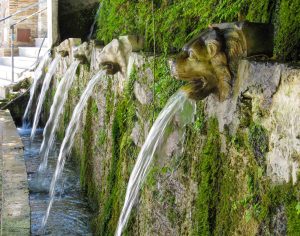 In Andros, many species of birds find shelter and food. Owls, nightingales, partridges, woodpeckers, turtledoves, goldfinches. Rare predators such as the Black Hawk, a dark-colored hawk that is one of the most endangered species in Europe. Mavropetritis breeds in the Cyclades in Andros and Skyros. He emigrates to spend the winter in Madagascar. Many small animals, badgers, rabbits, hedgehogs and hares find shelter in the vegetation. Also many water turtles and frogs.
In Andros, many species of birds find shelter and food. Owls, nightingales, partridges, woodpeckers, turtledoves, goldfinches. Rare predators such as the Black Hawk, a dark-colored hawk that is one of the most endangered species in Europe. Mavropetritis breeds in the Cyclades in Andros and Skyros. He emigrates to spend the winter in Madagascar. Many small animals, badgers, rabbits, hedgehogs and hares find shelter in the vegetation. Also many water turtles and frogs. Island of Culture and Art
And not unfair. Bright spirits who excelled in letters and arts were Andriotes, with of course the poet Andreas Empirikos leading the way. A special figure was Theofilos Kairis, one of the greatest Greek intellectuals of the 19th century. Like Michalis Dertouzos, a professor at MIT in the United States, who is considered the “father” of computer science.
If there is one Greek island in the Cyclades that “carries” a long history and “travels” in art and culture, it is Andros. Museums with world-wide exhibitions, finds and collections of great value, the maritime tradition and the imprint of the life of the island in every corner. Archaeological sites of special value such as Strofilas, the “oldest city in Europe” dating to 4,500 – 3,300 BC.

The Museum of Modern Art houses a collection of works by Greek and foreign artists. At the Kydonios Foundation, the plastic arts meet music, theater and literature. The Archaeological Museum with important findings from excavations in Andros and the Naval Museum reveals the history of Andrian shipping. The Museum of Folklore and Christian Art captures the life of Andros and Christian art. The Cairo Library with almost 3,000 volumes from the collection of Theophilos Kairis. The Archaeological Museum of Paleopolis with the only surviving hymn to honor in Isis. The Olive Museum of the Cyclades is a sample of a small livestock olive oil extraction unit.
With the Andros International Festival, Andros is present with high level cultural events in the Cyclades. Gavreotika with various cultural events, the concerts of the Philharmonic and the Choir of the Music Association, compose an art-loving Greek island in the Cyclades.
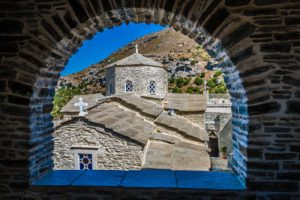 The Monastery of Panachrantos is located on the slope of Mount Gerakones, in the area of Fallica, and is the most beautiful Byzantine monastery of Andros. The Holy Monastery of Agia Marina is located in Apoikia, dates back to 1325 and became widely known for the miracle of healing a small child from Cyprus. The Holy Monastery of Agios Nikolaos is located in Vourkoti and is an imposing complex, of exceptional architecture and was a branch of the Friendly Society. The Monastery of Zoodochou Pigi is the largest monastery of Andros, located in Batsi and the locals call it “Agia” and celebrates the first Friday after Easter Sunday. The nunnery of Agia Irini is located near Apoikia and was built in 1780 by 2 monk brothers from the Arpachturia of Kato Apoikion.
The Monastery of Panachrantos is located on the slope of Mount Gerakones, in the area of Fallica, and is the most beautiful Byzantine monastery of Andros. The Holy Monastery of Agia Marina is located in Apoikia, dates back to 1325 and became widely known for the miracle of healing a small child from Cyprus. The Holy Monastery of Agios Nikolaos is located in Vourkoti and is an imposing complex, of exceptional architecture and was a branch of the Friendly Society. The Monastery of Zoodochou Pigi is the largest monastery of Andros, located in Batsi and the locals call it “Agia” and celebrates the first Friday after Easter Sunday. The nunnery of Agia Irini is located near Apoikia and was built in 1780 by 2 monk brothers from the Arpachturia of Kato Apoikion.
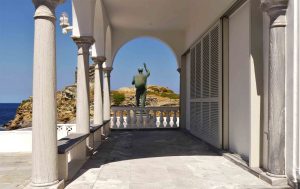
The Unknown Sailor is a monument that dominates the lower end of Chora, in honor of all the sailors who lost their lives at sea, and the Lower Castle right next to it is connected by a stone vaulted arch with Chora. The Castle of Faneromeni or Pano Kastro or Gria the Castle (where the famous beach “the old woman’s jump” took its name) was the largest medieval town of Andros and is located north of Korthio Bay, in Kochylos!
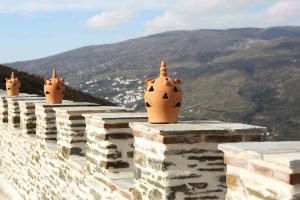 Neoclassical buildings, Venetian tower houses, stone houses coexist with the Aegean on a separate Greek island in the Cyclades.
Neoclassical buildings, Venetian tower houses, stone houses coexist with the Aegean on a separate Greek island in the Cyclades.
Farm houses, towers and mansions of captains. Buildings such as konakia, fountains, watermills and pigeon houses decorated with triangular shapes. One stone on top of the other with the craftsmanship of the local craftsman, the dry stones divide the fields on the slopes of the mountains and at the same time hold the soil (bloody). On the island there are several stone bridges, made of slate, were part of the old transport network.
Beaches
Andros has many beaches of exceptional quality, which satisfy all tastes. Beaches for families, fully organized and easily accessible, but also secluded beaches. Beaches with cold (to crystal clear) waters and others, much warmer. Beaches with rich sand, but also pebbles and rocks for those who love fishing.
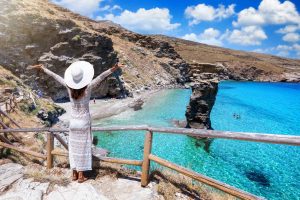
On the west side of Andros are the long sandy beaches of the island, all leeward, easily accessible and used for tourism, as almost all have sunbeds and beach bar, while in several there are picturesque taverns.
PISO LIMIONAS is located in the northwestern part of the island
FELLOS is located in the northwestern part of the island
AGIOS PETROS is located next to the main road that leads from Batsi to Gavrio
CHRISSI AMMOS is located next to the main road that leads from Batsi to Gavrio
KYPRI is located on the west side of the island, on the main road that leads from Batsi to Gavrio
AGIOS KYPRIANOS is located on the west side of the island, on the main road that leads from Batsi to Gavrio
BATSI is located in the homonymous village
STIVARI, ANEROUSSA, AGIA MARINA are located on the west side of the island, after Batsi, towards Chora.
PALEOPOLI is located on the west side of the island, at the end of the homonymous village.
HALKOLIMIONAS AND APOTHIKES are located right in the center of the west side of the island, in the area of Stavropeda.
PLAKA is located on the southwest side of Andros, on the road to Korthi.
On the east side of Andros are the best beaches of the island. However they are all exposed to meltemia and northeast winds. When, however, there are no meltemia the visitor has the opportunity to swim in beaches of unique beauty.
KORTHI-MYLOS is located in the homonymous settlement of Andros, in the southeastern part of the island.
VINJI is located on the southeast side of the island, in the area of Korthi.
GRIAS TO PIDIMA is located on the southeastern side of the island, in the northern part of Ormo Korthiou.
SYNETI is located on the east side of the island, between Chora and Korthi.
PARAPORTI is located in the east of the island. It is one of the two coves that “embrace” the island’s capital, Chora.
NEIPORIO is located in Chora. It is the second cove that “embraces” the capital of the island.
GIALIA (Front and back) are located on the east side of the island, just after Chora, in the village of Stenies.
ACHLA is located on the east side of the island, north of Chora.
VORI is located in the eastern part of the island, near the village of Arni.
ATENI is located in the eastern part of the island, relatively close to Batsi
VITALI is located on the northeast side of the island, near the homonymous village.
ZORKOS is located on the northeast side of the island.
PEZA (Small and Large) are located on the north side of the island
Sources * https://andros.travel , https://andros-guide.gr , https://andros.gr

